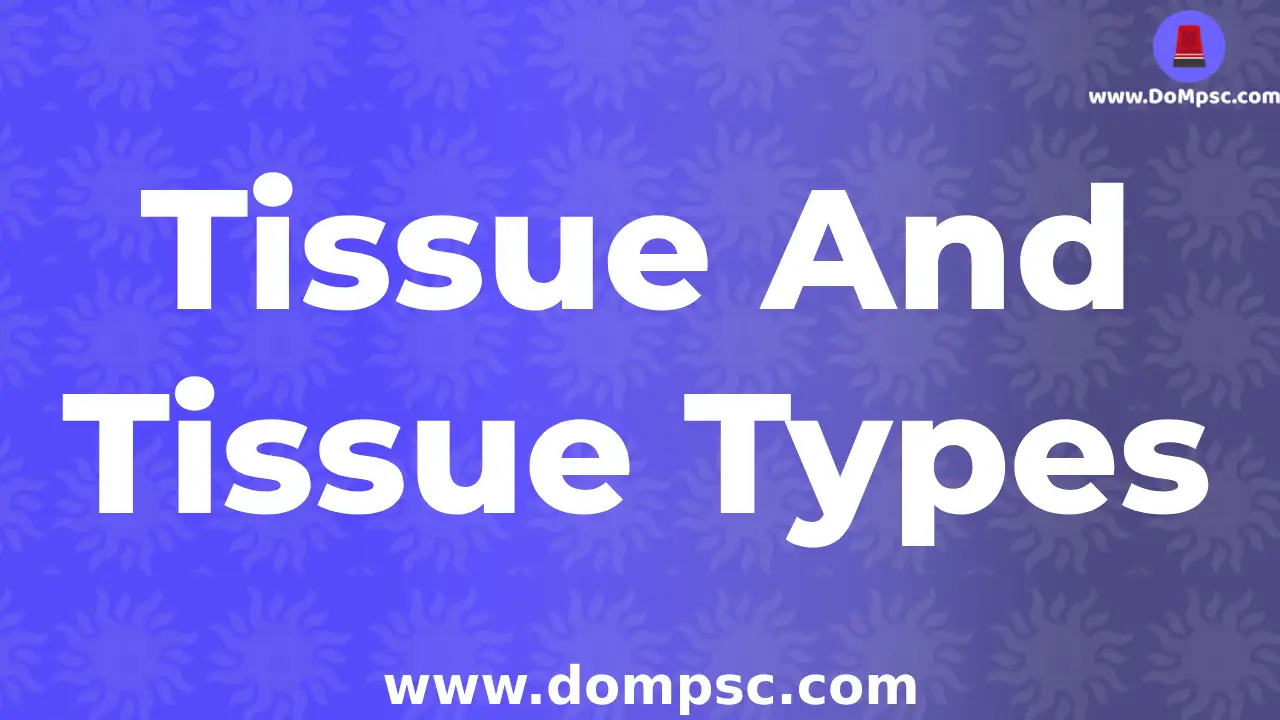MPSC Tissue and its types(उती आणि उती प्रकार)-MPSC Biology science notes

✪ Download pdf Works Properly on chrome Browser ✪
Tissue and its types(उती आणि उती प्रकार)

By Shubham Vyawahare
0-May-2025
Table Of Contain-Mpsc Tissue and its types
Introduction of Tissue and its types
Written BY:Shubham Vyawahare
Simple Body Structure
➤ Tissue are the group of cell having similar properties.
➤ Study of Tissue related science is know as Histology.
➤ The Histology Discovered by Marecello Malpighii.
✪ Types Of Tissue ✪
➤ Tissue are further divided on the basis of structure and functionality.
Simple Tissue
➤They are made with a single cells
➤ This tissue has simple structure because of same functionality
Epithelial Tissue
➤Stricture of this tissue are very complex and crowded.
➤ Generally they are found in skin mouth and blood.
➤ The main function of this tissue is to protect body
1.Simple Squamous Tissue
➤A simple squamous epithelium is a single layer of flat cells in contact with the basal lamina.eg. Blood
2. Stratified Tissue
➤ Stratified tissue contains cells of varying flatness on different layers.Protect Skin
3. Columnar Tissue
➤ They are Structured like a column
➤ Generally secrets digestive juice for tissue.
4.Cilliated Columnar Tissue
➤ They are Structured like a column
➤ Generally takes a part in a inhalation process.
5.Cuboidal Tissue
➤ They are Structured like a Cube
➤ Reabsorb the useful content from a excretion process .
➤ Secretes a Saliva.
6.Glandular Tissue
➤ Main Function is to secretes a non useful content
✪ Complex Tissue ✪
➤ This tissues are called as complex because they are made up of a one or more cells and works together
Connective Tissue
➤Connective tissue is found in between other tissues everywhere in the body
1.Bone
➤ Back support of a cells.
➤made with calcium and phosphorus mixture.
➤ cortical bone and cancellous bone Found in a cell.
2.Blood
➤ This is liquid form of a connective tissue
➤Basically Transfer all absorbed food to every part of cell
➤ It contain rbc wbc and plasma
3.Ligament
➤This are the bond between bones
➤ Basic function is to support skeletal system
4.Tendons
➤ tendon is a fibrous connective tissue which attaches muscle to bone
➤A tendon serves to move the bone or structure
➤Tendons are muscles
5.Cartilage
➤Cartilage performs important functions inside the complex structure of our joints
6.Areolar
➤ Areolar connective tissue is connective tissue within the body and is named after the airy appearance of the tissue
➤It is Placed between blood vessels,nerve bundles,muscles.
➤It also fills the spaces between organs and connects skin to underlying muscle
7.Adipose
➤ This is a specialized connective tissue consisting of lipid-rich cells called adipocytes
➤This tissue is to store energy in the form of lipids (fat).
Mascular Tissue
➤Compression and Extraction of tissue happens due to contractile protein present in muscular tissue
1.Voluntary Tissue
➤ It is a form of striated muscle tissue, which is under the voluntary control of the somatic nervous system.
➤It is work for a controllable movements
➤muscle whose action is normally controlled by an individual's will; mainly skeletal muscle
➤Smooth Muscle Tissue and skeletal muscle are voluntary muscles
➤located in walls of hollow visceral organs, except the heart, appear spindle-shaped
2.Involuntary Tissue
➤The autonomic (automatic or visceral) nervous system regulates individual organ function and is involuntary
➤The 3 types of muscle tissue are cardiac, smooth, and skeletal.
➤Cardiac muscle cells are located in the walls of the heart, appear striated, and are under involuntary control
➤ There are some important points in Involuntary tissue as below
NervousTissue
➤ Nervous tissue is the term for groups of organized cells in the nervous system, which is the organ system that controls the body's movements.
➤Work Controlled by mind
Dendrites
➤Dendrites bring information to the cell body
➤Neurons have specialized projections called dendrites
➤Dendrites are appendages that are designed to receive communications from other cells
➤ hey resemble a tree-like structure, forming projections that become stimulated by other neurons and conduct the electrochemical charge to the cell body
Cyton
➤Cyton is the central or cell body of a neuron containing the nucleus and excluding its processes.
➤ Perform growth and maintenance of cell
➤ Cyton receives electrical impulses from other neurons through dendrites
➤ Cyton: It is the cell body, with a central nucleus surrounded by cytoplasm.
Axon
➤axons take information away from the cell body. Information from one neuron flows to another neuron across a synapse
➤ nerve fibre, portion of a nerve cell (neuron) that carries nerve impulses away from the cell body
➤ A neuron typically has one axon that connects it with other neurons or with muscle or gland cells
➤ After nerve injury, axons readily regenerate
➤The axon carries the nerve impulses (action potential) away from the cell body to another neuron or to an effector organ such as a muscle
✪ Plant Tissue ✪
➤there are two Type of plant tissue
- Merismestic Tissue
- Permanent Tissue
Merismestic Tissue
➤Apical Meristem: capable of division and growth in the root
➤Lateral:Plants use lateral meristem tissue to grow in diameter as part of secondary growth
➤Intercalary:Associated with the growth in length in the middle position
Permanent Tissue
➤This tissue are produced from a division of cells and after sometime perform a very particular task
simple Permanent Tissue
These Tissue are made from same type of cells.
➤ Parenchyma:Parenchyma cells have usually thin cell wall made of cellulose,Found In bit
➤Collenchyma:Collenchyma tissue is alive..Work as a Food Storage.
➤Sclerenchyma:The component cells are usually ‘prosenchymatous’, a term once used to designate the cells much longer than breadth.
Complex Permanent Tissue
These Tissue are made up with different tissue and work together with their own functions.
➤ Xylem(जलवाहिनी):Xylem, plant vascular tissue that conveys water and dissolved minerals from the roots to the rest of the plant and also provides physical support.
➤ Phylum(रसवाहिनी):tissues in plants that conduct foods made in the leaves to all other parts of the plant. Phloem is composed of various specialized cells called sieve tubes, companion cells, phloem fibres, and phloem parenchyma cells.
Others Blogs Related to MPSC Biology Notes
➤Biology Exam Pattern
➤Blood Circulation System
➤Blood Groups And Its Diseases
➤Balanced Diet And Nutrients
➤Classification Of Animals
➤Classification OF Plants
➤Cell
➤Tissue
➤Coordination In Human
➤Digestive System
➤Diseases And Disease Types
➤Excretory System
➤Respiratory System
➤Reproductive System
➤Skeletal System
Read All MPSC blogs
- ➤केंद्र सरकारने खाजगी क्लासेस साठी नवी नियमावली लागू केली आहे |GUIDELINES FOR REGULATION OF COACHING CENTER in marathi
- ➤MPSC Data leak: पेपर न फुटल्याचा दावा MPSC आयोगाने स्पष्टपणे केला आहे
- ➤MPSC hall ticket data leaked before 6 days of exam
- ➤MPSC Data leak: टेलेग्राम वर अचानक ९० हजार परीक्षार्थींचे प्रवेशपत्र झाले लिक
- ➤मराठी भाषेला अभिजात दर्जा मिळायला हवाच , अभिजात दर्जा नेमका कसा मिळतो ?
MPSC Books pdf



